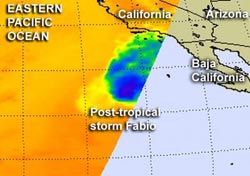NASA sees withering post-tropical storm Fabio moving toward coast

When NASA's Aqua satellite passed over post-tropical storm Fabio on July 18 at 1023 UTC (6:23 a.m. EDT) it detected very little strong convection and heavy rainfall (blue area). Sea surface temperature dropped below 22 Celsius (71.6 Fahrenheit) and can't support a tropical cyclone. Credit: Credit: NASA JPL, Ed Olsen<br>
When NASA's Aqua satellite passed over post-tropical storm Fabio on July 18 at 1023 UTC (6:23 a.m. EDT), the Atmospheric Infrared Sounder (AIRS) instrument captured temperatures of cloud tops and the sea surface. AIRS data showed very little strong convection and heavy rainfall occurring in the post-tropical storm and it was north of the center of circulation. Wind shear from the south is pushing the showers north of the center.
Sea surface temperatures are not warm enough to support a tropical cyclone because they are colder than 22 Celsius (71.6 Fahrenheit) in the area Fabio is moving through.
At 11 a.m. EDT on July 18, the National Hurricane Center issued their final advisory on post-tropical storm Fabio. At that time, Fabio was about 535 miles (855 km) south-southwest of San Diego, California, near latitude 25.7 north and longitude 120.8 west. Fabio's maximum sustained winds were near 30 mph (45 kmh) and weakening. It was still moving to the north at 9 mph (15 kmh) but is expected to turn to the north-northeast.
Doppler radar images from San Diego, Calif. showed some shower activity from Fabio approaching the area at 11 a.m. EDT on July 18.
The National Hurricane Center expects Fabio to dissipate in a couple of days. Meanwhile, large ocean swells, rip tides and dangerous surf conditions continue to affect the coasts of Baja California, Mexico and southern California.
Media Contact
More Information:
http://www.nasa.govAll latest news from the category: Earth Sciences
Earth Sciences (also referred to as Geosciences), which deals with basic issues surrounding our planet, plays a vital role in the area of energy and raw materials supply.
Earth Sciences comprises subjects such as geology, geography, geological informatics, paleontology, mineralogy, petrography, crystallography, geophysics, geodesy, glaciology, cartography, photogrammetry, meteorology and seismology, early-warning systems, earthquake research and polar research.
Newest articles

Properties of new materials for microchips
… can now be measured well. Reseachers of Delft University of Technology demonstrated measuring performance properties of ultrathin silicon membranes. Making ever smaller and more powerful chips requires new ultrathin…

Floating solar’s potential
… to support sustainable development by addressing climate, water, and energy goals holistically. A new study published this week in Nature Energy raises the potential for floating solar photovoltaics (FPV)…

Skyrmions move at record speeds
… a step towards the computing of the future. An international research team led by scientists from the CNRS1 has discovered that the magnetic nanobubbles2 known as skyrmions can be…




















